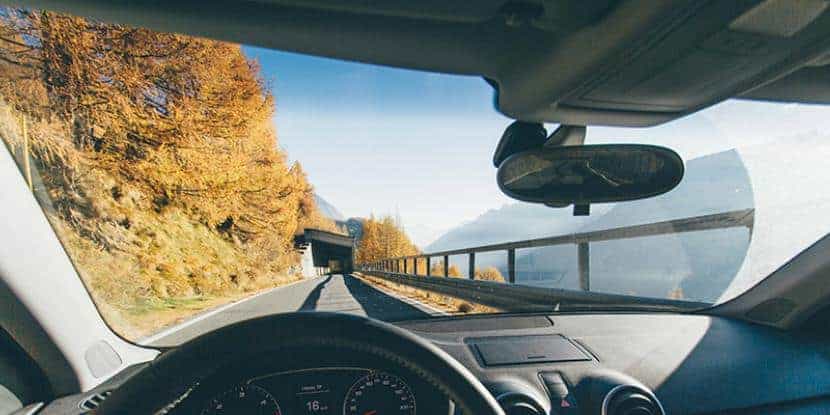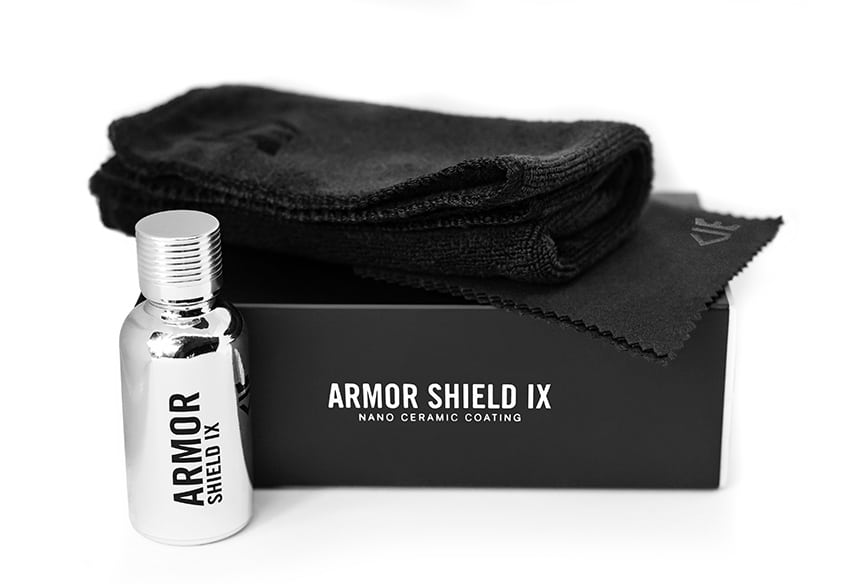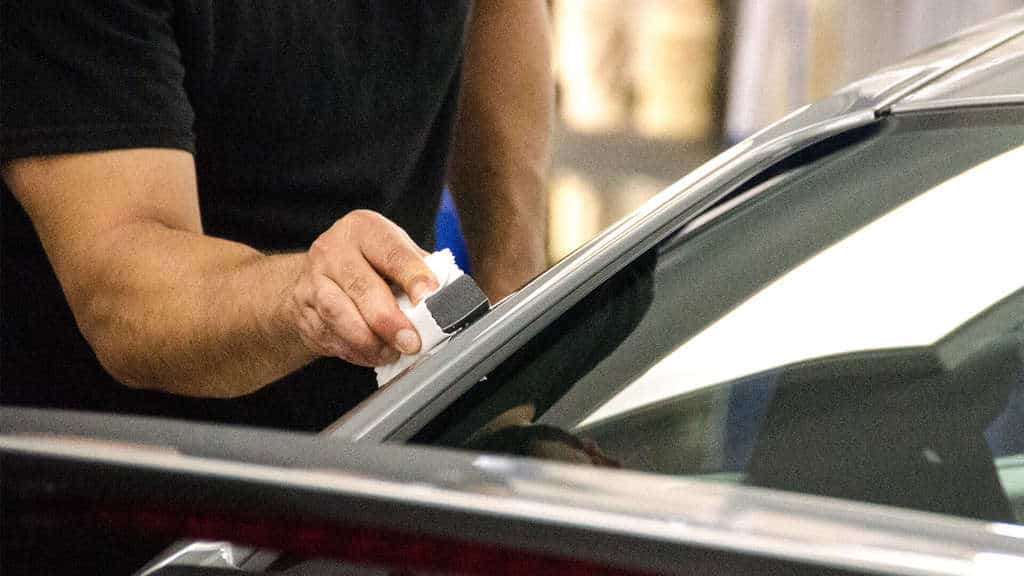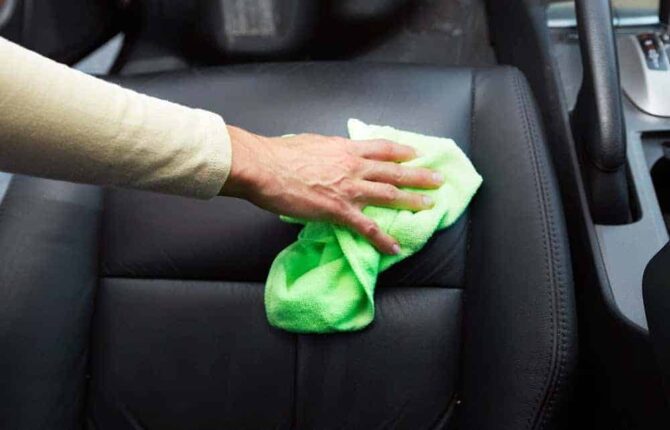Did you know that ceramic coating can be used on automotive glass? Well, to quote Officer John McClain from the movie Die Hard – “Glass – who gives a shit about glass?” In retrospect, McClain is right.
As automotive enthusiasts, we tend to focus so much effort on protecting our paint, keeping our wheels and tires clean, but how often do we do anything to really protect our windshields, driver and passenger side windows, and rear windshields?
Since we depend on the clear and clean glass to maintain optimal visibility, it makes sense that finding a creative way of improving the ability to see clearly – especially during rainstorms. This can be accomplished by applying a ceramic car coating.
Ceramic coatings, like Armor Shield IX, can be applied to car paint, wheels, fiberglass, vinyl wraps, PPF, and yes – glass. In today’s article, we’ll provide a definitive guide to how to apply a ceramic coating on the glass. We’ll outline how this process is completed, why it’s a good idea, and answer some FAQ’s surrounding using our product on glass products.
While there are several ceramic spray glass coating products used by the professional detailer or others that help to improve hydrophobic properties, the main issue with them is longevity.
Why is Applying a Ceramic Coating to Glass a Smart Idea?

Those who opt for nanoceramic coatings as their paint protection product of choice understand the value of longevity. They know how great these products are at repelling water, reducing surface tension, and repelling contaminants. As such, it makes sense to apply this same technology on the glass on your car, truck, or SUV.
For those that are still learning about ceramic coatings, here is a brief lesson on how they work. (For more information read our Ultimate guide to Ceramic Coating.)
Nano-ceramic coatings are scientifically engineered synthetic liquid products, manufactured with precision percentage levels of ingredients ranging from SiO2 (silica dioxide) to activation of Fluorine.
The ceramic car product is highly concentrated but very safe to use. When it is applied to a surface, it bonds to the upper-most layer of the material and creates a semi-permanent layer of protection that is fully transparent and exceptionally strong.
What are the Benefits of Applying Ceramic Coating on Glass?
Most ceramic coatings – at least the good stuff can maintain its integrity for more than 3+ years. This is arguably the best reason why using a DIY ceramic coating on glass surfaces is such a good idea.
However, there are more reasons why ceramic coating application to glass is better than waxes and is a smart investment for the car, SUV, and truck owners.
Improved Visibility
Arguably the time period that is hardest to see out of the front windshield, through side-glass and the rear window is rainstorm activity. When it rains, water beads up on the glass surface and is only removed from the windshield when the wipers are engaged. However, there are times during torrential downpours when it’s incredibly difficult to see through the windshield because it appears that the water is sticking to the windshield.
This is where the hydrophobic properties of ceramic coatings are exceptionally beneficial.
A ceramic pro coating leaves an exceptionally smooth and flat surface, that repels water. The ceramic paint protection means that during rainstorms, the windshield, car glass, and other windows that are protected will be easier to see, providing enhanced visibility, which provides you with better control of the vehicle.
With improved visibility, you can avoid accidents easier, see clearer, and make better defensive driving decisions.
Easier to Clean

Let’s say for the sake of argument that you’re driving down the road after a rain shower. The asshat in front of you hits a pothole, has no mud flaps on his lifted Jeep Wrangler, and your windshield gets splashed with muddy water. Under normal circumstances, you have to activate the wipers, and the glass cleaner, and wait more than a few seconds to remove this shit from the windshield.
Not if you use a ceramic coating.
This video provides a real-world example of how well it repels muddy water. The ultra-slippery ceramic coated glass surface literally let’s mud and dirty water slide off the surface. But that’s not all (in my best infomercial voice).
Hard to remove and annoying contaminants like bird shit, bug guts, tree sap and more simply wipe off without much effort. This is especially helpful for commercial truckers or those who travel roads less traveled frequently on road trips. It keeps the windshield cleaner, longer. And when it does become dirty due to suicidal bugs, the windshield is simple to clean.
Exceptional Clarity

There are some glass treatment products that claim to improve visibility or repel water. But, when they are applied, they can leave a cloudy film, which is enhanced during low light hours like sunrise or sunset. Cloudy conditions can also reduce visibility when using inferior glass protection products.
The professional DIY ceramic coating, on the other hand, leaves no film, residue, or negatively impacts the visibility through the window. You simply prep the surface first, apply the coating as directed, and buff off. This is due to the incredible technology infused into today’s advanced ceramic coatings.
They have been developed to provide multiple protective properties on multiple surfaces, including all types of glass. Not only does it apply clear, but it also has exceptional UV resistance properties. This helps to reduce glare by subtly improving the optical defects of automotive glass. The anti-glare properties are also helpful during night-time driving.
Reduces Scratch Potential

When a ceramic coating cures, it’s exceptionally strong and durable. In fact, it can last for anywhere from 2 to 5 years when properly prepped and applied. One of the better features of these products is that they also provide very good anti-scratch properties.
For automotive glass, it will help extend the lifespan of glass with reduced scratches, usually caused by blowing sand. However, one thing it can’t help is to reduce those annoying rock chips. A solid object hitting the glass at 55 mph or higher is going to penetrate even the strongest ceramic coatings.
How to Apply Ceramic Coating to Glass
The process of applying a ceramic coating to glass is no different than applying it to paint, headlights, wheels, or any other surface. However, it’s important to explain why each step should be completed, especially with glass.
Prep Work Required
The first step in the ceramic coating process on glass is to prep the surface for application. In this article we go in-depth to outline the complete prep process, but for sake of simplicity, here are the general steps.
However, before we get too technical, an important first step is to inspect the glass for its condition – especially the front windshield. If the windshield is damaged, it’s a good idea to have it replaced first, so you have a fresh canvass to work on. Plus, ceramic coatings will not stop window cracks from expanding. The damage is internal in most cases, so you’ll eventually have to replace the windshield if it’s damaged.
Washing

Washing the glass is crucial for the successful application of any ceramic coating product. The last thing you want to do is have minor debris or contaminants stick under the hard layer of protection. So, always start the prep process by washing all the glass that you want to treat with the coating.
Use automotive specific car wash shampoo or soap, the two-bucket method, and dry completely using a microfiber towel.
Clay Bar

The second step for prepping automotive glass for a ceramic coating is using a clay bar treatment. Even when you wash the glass correctly, there will be microscopic imperfections and contaminants left on the glass. This step removes the majority of that hard to remove crap, which gives you a better opportunity for exceptional results.
Final IPA Wipe Down

The final step in the prep process for applying a ceramic coating is the IPA or Isopropyl Alcohol wipe down. This removes any contaminants missed by the clay bar treatment. It also removes any oils, grease, or wax and polish that may be left on the glass.
*Important Reminder: It’s crucial to complete these three steps on ANY glass surface you wish to protect. It’s quite common for people to forget to complete this on side door glass or rear glass, and only to focus on the front windshield.
Applying the Coating to Glass
Once you’ve completely prepped the glass surface as recommended above, you’ll be ready to apply the ceramic coating.
The first thing we recommend is to complete this job indoors or definitely out of direct sunlight. Exposure to sunlight will accelerate the curing or flash process, which will negatively impact the application and durability.
Now that we’ve clarified that, here is the process:
- Grab your foam block and wrap a microfiber suede around it.
- Shake the bottle of Armor Shield IX ceramic coating before opening.
- Apply a straight line of ceramic coating on your application microfiber cloth. Cover the cloth from the top to bottom, but just a thin line, not the entire cloth.
- Start by applying the ceramic coating in a 2-foot x 2-foot section on the glass. It’s best to apply in a straight line from left to right and from top to bottom.
- Let the coating cure. When it’s applied to body panels, it usually takes about 5 minutes to initially cure. However, it’s a bit quicker on the glass. So, for optimal results, remove the coating with a clean microfiber cloth a few minutes after application.
- Buff the residual from the glass surface using a clean microfiber towel. It is VERY important to completely remove residue, as any excess left on the windshield will leave streaks.
- Use an inspection light to verify all excess has been removed. Complete additional buffing if needed.
Repeat each step listed above until you’ve finished the entire glass panel. Always remember to replace microfiber suedes anytime the suede hardens.
Curing Time and After Care for Ceramic Coating on Glass
When you’ve finished the application process on all the glass you intend on treating, feel free to let the vehicle sit outside in the sun. This will expedite the curing process. However, it’s crucial to not let the glass become exposed to water for a minimum of 48 hours.
Featured Product

Armor Shield IX DIY Kit
The Most Complete Ceramic Coating DIY Kit for Consumers
The DIY Kit includes everything you need to perform a professional grade ceramic coating without any prior experience. Get the feeling of driving a new car, every day.
For optimal results, aftercare should consist of using standard automotive soap and the typical two-bucket washing method. It is not recommended to use glass cleaners, as the chemicals will gradually penetrate the ceramic coating protectant layer and reduce hydrophobic properties.
Wrapping it Up

Applying a DIY ceramic coating like Armor Shield IX is simple, convenient, and longer-lasting alternative to many of the growing spray coating products sold today. When prepped correctly and applied as recommended, the coating can protect your windshield for 2 to 5 years.
As with any application, if you have questions, don’t hesitate to contact us directly, or leave your questions or comments in the section below. You can also follow us on Facebook to receive frequent updates and tech tips to get the best bang for your Armor Shield IX buck.













23 comments
Terry Benedict
What about coating the interior glass?
What about coating the interior glass?
gabbar garage
Irresistible! Thank you so much for this kind and good service.your services is better than better.
Irresistible! Thank you so much for this kind and good service.your services is better than better.
Tim
Hi,
I applied Armor Shield iX to my windshield, and forgot to buff it after it flashed. What is the best way to deal with the streaks on the window at this point?
Thank you,
Tim
Hi,
I applied Armor Shield iX to my windshield, and forgot to buff it after it flashed. What is the best way to deal with the streaks on the window at this point?
Thank you,
Tim
Dale Pearl
Hi Darwin!
Armor Shield will prevent oxidation as well as fading paint with UV blocking! Armor Shield is essential if you are parking your car outdoors and exposing it to the elements 24/7.
Hi Darwin!
Armor Shield will prevent oxidation as well as fading paint with UV blocking! Armor Shield is essential if you are parking your car outdoors and exposing it to the elements 24/7.
darwin
my aluminum semi truck wheels constantly oxidize. It i polish them and then apply the coating will they maintain the shine?
my aluminum semi truck wheels constantly oxidize. It i polish them and then apply the coating will they maintain the shine?
Dale Pearl
Hi Jeff!
A good tip to avoid those streaks especially on glass is to use a flashlight as you coat so you can see the layering more precisely.
I would suggest a series of increased buffing to try to remove the streaks. Message us at hello@test3.unicorns.rocks and I’ll send you a detailed troubleshooter to help with the streaks and or high spots.
Hi Jeff!
A good tip to avoid those streaks especially on glass is to use a flashlight as you coat so you can see the layering more precisely.
I would suggest a series of increased buffing to try to remove the streaks. Message us at hello@test3.unicorns.rocks and I’ll send you a detailed troubleshooter to help with the streaks and or high spots.
Jeff Smith
I used the ceramic coating on my car and windshield and followed all of the steps. It done amazing on my car but on my windshield it is very streaky at night and in direct sunlight no matter how well I clean it with water or a mixture of alcohol, vinegar and water. Any suggestions?
I used the ceramic coating on my car and windshield and followed all of the steps. It done amazing on my car but on my windshield it is very streaky at night and in direct sunlight no matter how well I clean it with water or a mixture of alcohol, vinegar and water. Any suggestions?
Dale Pearl
You definitely can do that and helps to bring about an ultra-smooth surface. You may find yourself not needing to use your wiper blades at all!
You definitely can do that and helps to bring about an ultra-smooth surface. You may find yourself not needing to use your wiper blades at all!
Dale Pearl
Probably not and here is why. The thickness of the coating can cause the windshield wiper blade to stutter and in doing so the tension will tear the coating.
Probably not and here is why. The thickness of the coating can cause the windshield wiper blade to stutter and in doing so the tension will tear the coating.
Christopher Huggins
Is it a good idea to put more than one coat of ceramic on the windshield?
Is it a good idea to put more than one coat of ceramic on the windshield?